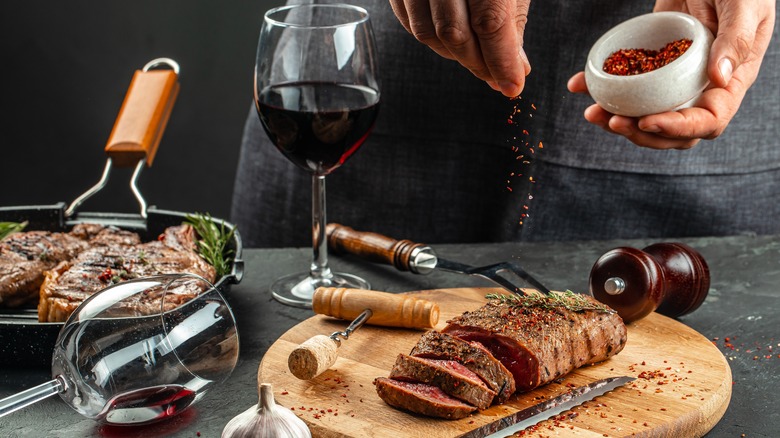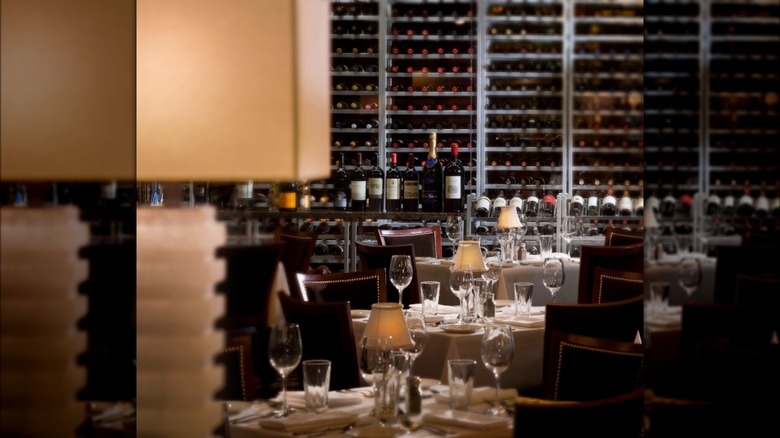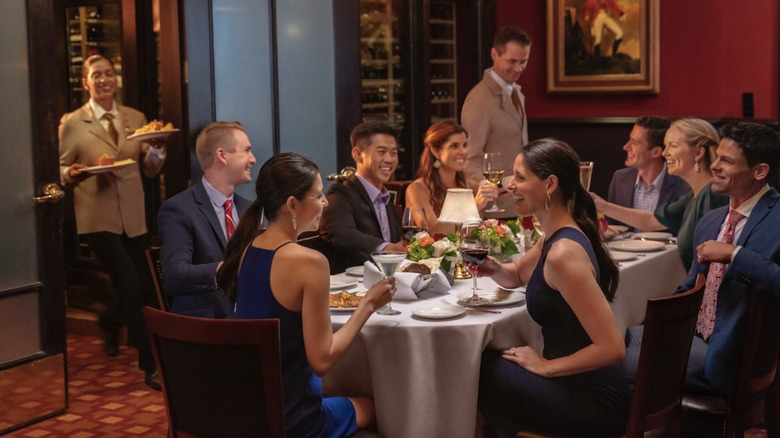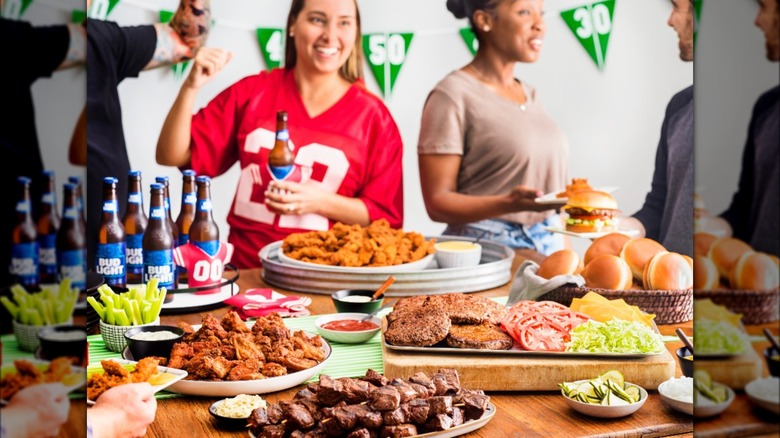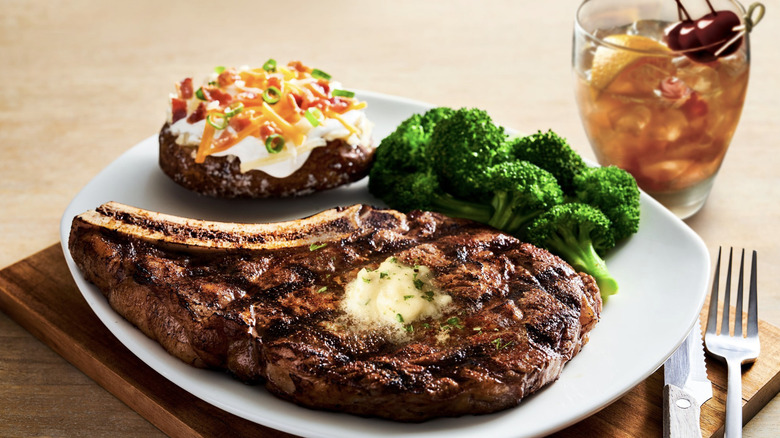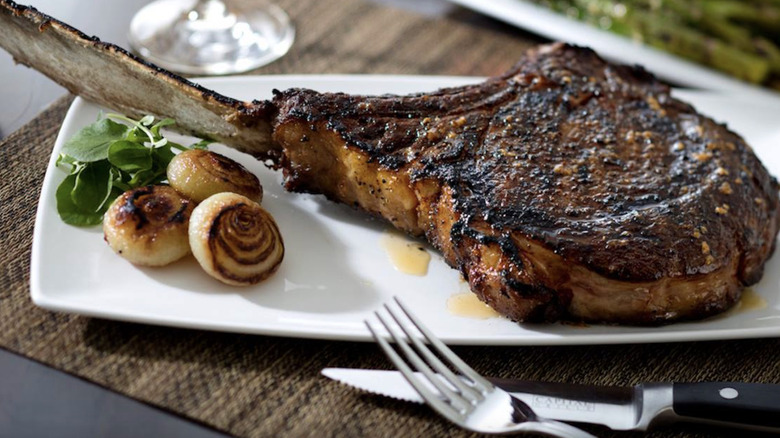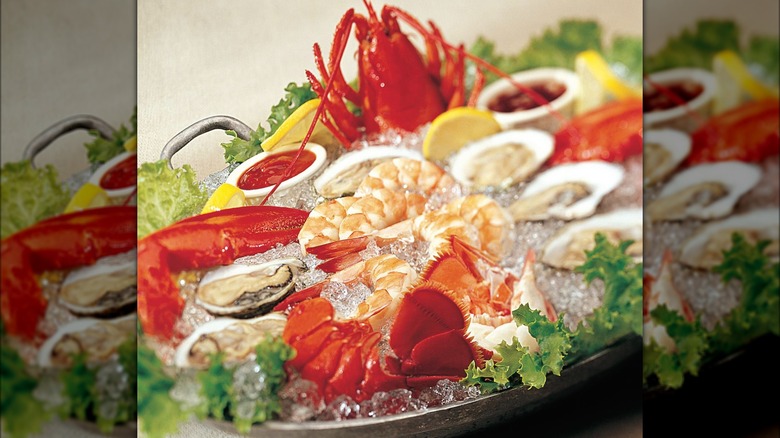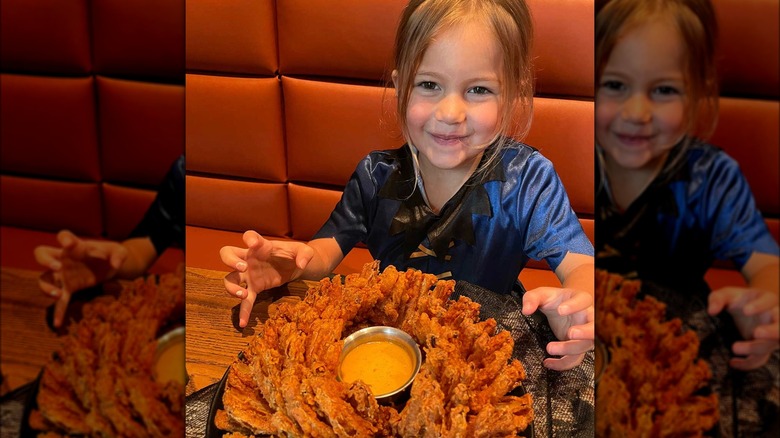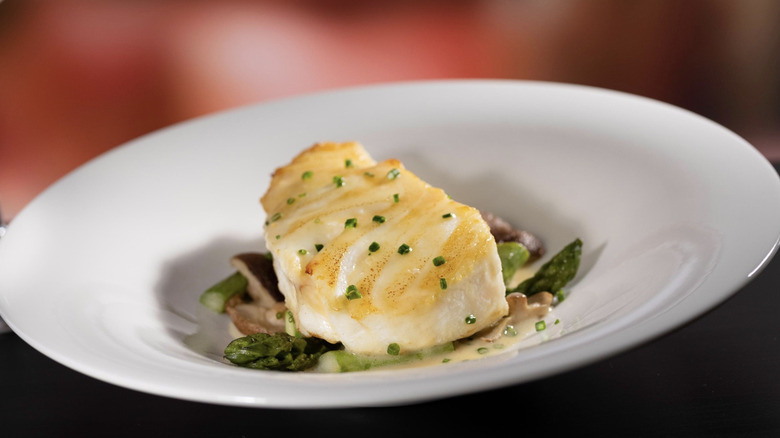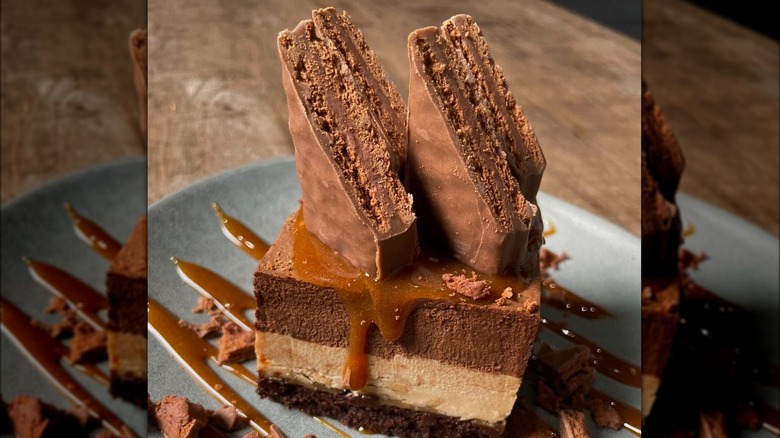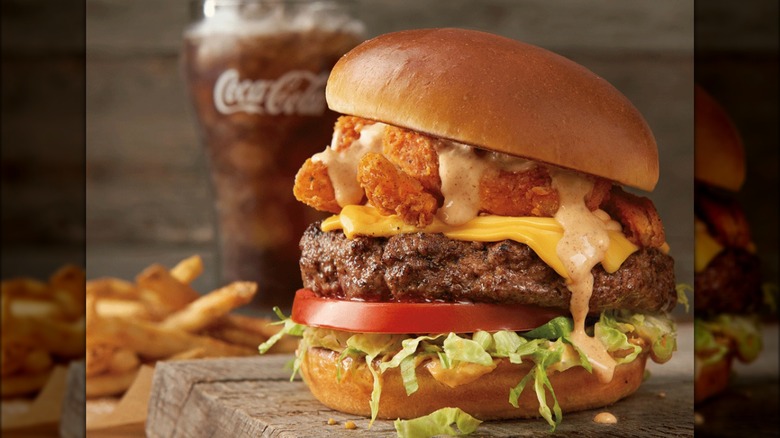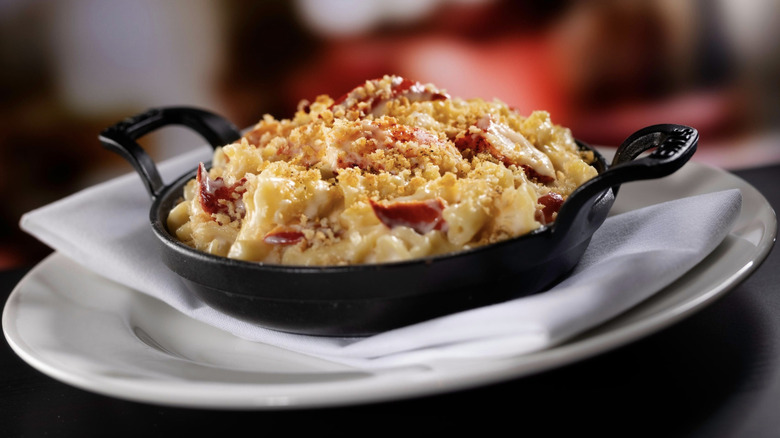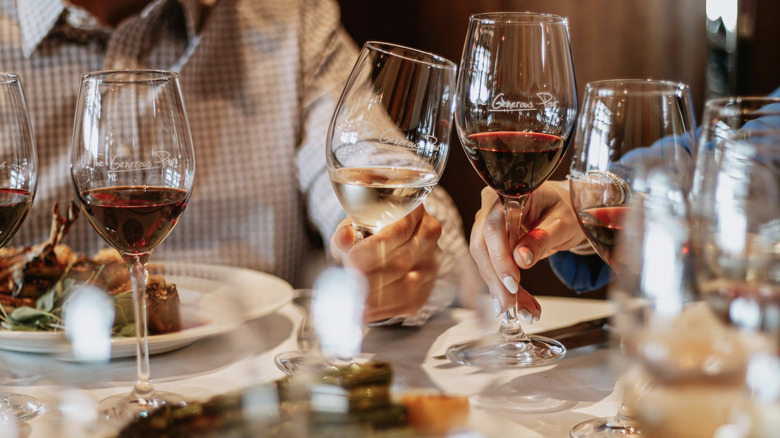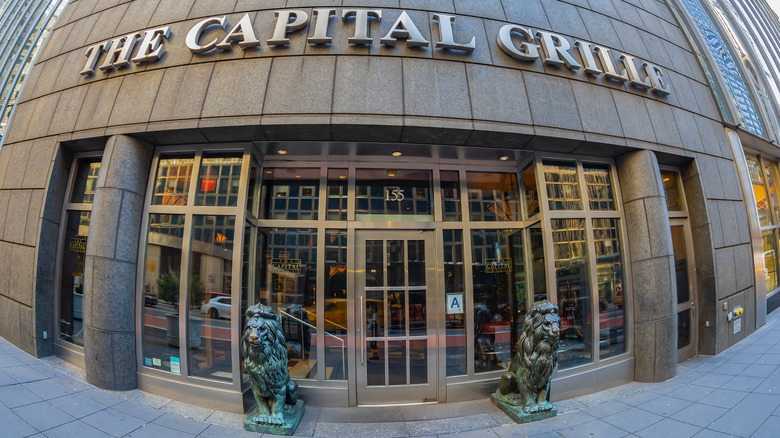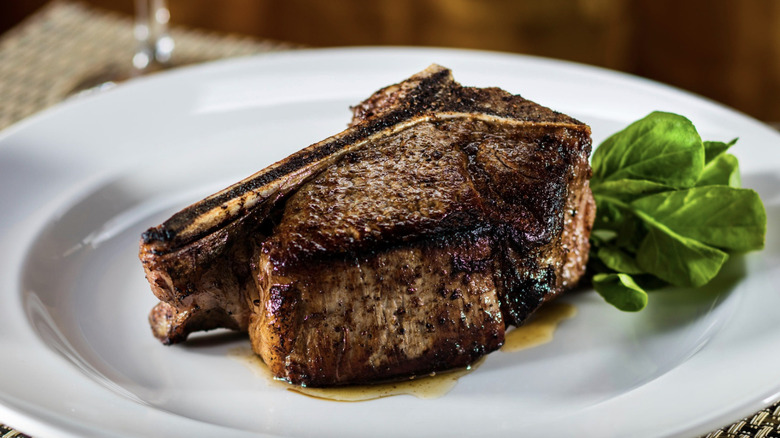The Capital Grille Vs Outback Steakhouse: Which Is Better?
Known for succulent New York strips and tender filet mignons, steakhouses are a cherished part of American culinary culture. However, not all such establishments are created equal, with some focusing on premium cuts and sophisticated atmosphere, and others offering a more casual dining experience tailored to families and informal get-togethers. The Capital Grille and Outback Steakhouse sit at the opposite ends of this spectrum.
The Australian-inspired Outback Steakhouse is a casual chain that serves decent quality steaks and a range of other dishes, including salads, burgers, and sandwiches. The budget-friendly restaurant is a favorite with families and groups of friends looking for a laid back dining experience that's not going to break the bank. On the other hand, The Capital Grille offers a more refined dining atmosphere where patrons can indulge in high-quality steaks and premium seafood, making it well-suited for formal gatherings and business meetings.
Our quest to determine whether The Capital Grille or Outback Steakhouse offers a better dining experience has been nothing but thorough. We have spent hours examining each restaurant's atmosphere, menu, and services. For more information about this process, please refer to the final part of this article.
The Capital Grille has a more sophisticated atmosphere
While no two Capital Grille restaurants are exactly the same, all exude the same upscale atmosphere. In fact, the chain prides itself on the unique stylistic touches at each of its locations. Many Capital Grille restaurants feature rich wood paneling, striking chandeliers, and creative spotlighting, with some building on these features with a variety of unique elements. For instance, the chain's Las Vegas outpost features floor-to-ceiling windows overlooking the Las Vegas Strip. Other Capital Grille restaurants are unique due to their locations in iconic buildings such as Providence's historic Union Station, Seattle's 1910 Cobb Building, and New York City's ultra-modern Trylon Towers.
A world apart from The Capital Grille's high-end atmosphere, Outback Steakhouse is a laid-back Australian-themed chain with decorative elements that include boomerangs and Foster's beer signs. According to the chain's website, the dining experience at the restaurant is akin to being "right there in the Australian Outback." Nevertheless, some have criticized the chain for being kitschy and not reflective of modern-day Australia. Perhaps this is why some of the chain's locations have been updated with more present-day aesthetic elements such as paintings of the Sydney Opera House.
The Capital Grille is more expensive
Being a more sophisticated dining establishment, The Capital Grille is decidedly more expensive than Outback Steakhouse. While both steakhouses offer similar steak cuts, you can rest assured that your check will be noticeably higher at The Capital Grille than at Outback. For instance, an 18-ounce bone-in ribeye starts at $31.99 at Outback, whereas a slightly larger 22-ounce version of the dish at Capital Grille will set you back about $83.
Another example is Outback's 8-ounce filet mignon, which starts at $31.99, compared to Capital Grille's 10-ounce filet mignon priced at around $65. Moving away from steaks, the chains offer several similar dishes that feature very different price points. The Roasted Chicken Breast with mushrooms and Parmesan risotto at Capital Grille costs about $44 while the Bloomin' Fried Chicken with two sides at Outback is $20.99. Additionally, the Seared Citrus-Glazed Salmon with Marcona Almonds and Brown Butter is approximately $48 at Capital Grille, while the Perfectly Grilled Salmon with two sides at Outback starts at $24.99. Finally, the Seared Pepper Ahi tuna appetizer at Outback starts at $17.99, while the Sushi-Grade Sesame Seared Tuna starter at Capital Grille is around $40.
Outback Steakhouse has more locations
According to one of the founders of Outback Steakhouse, Chris T. Sullivan, the masterminds behind the venture never expected how big it would become. "When I and three friends opened the first Outback Steakhouse in March 1988, in Tampa, Florida, we hoped it would be successful enough to spawn a few more nearby," Sullivan writes in the Harvard Business Review. Today, it's clear that the chain has achieved much more than just spawning a few more locations. With around 670 restaurants across the U.S., Outback Steakhouse is somewhat of a household name in the country. Having said that, the chain has the biggest presence in Florida, Texas, and California. Outback Steakhouse also has a large international presence, in countries such as Australia, China, Ecuador, and Mexico.
The first Capital Grille opened its doors in Providence, Rhode Island, in 1990. Interestingly, the restaurant made its debut at the Union Station, which served as a hub for around 300 trains daily around 100 years ago. Despite its grand start, today The Capital Grille has a much more humble footprint than Outback Steakhouse, with 72 locations across the U.S. The chain has the greatest presence in Florida with 11 restaurants, Texas with seven restaurants, and New York with five locations. Unlike Outback Steakhouse, The Capital Grille hasn't expanded internationally.
Outback Steakhouse serves USDA Choice beef while The Capital Grille specializes in USDA Prime cuts
Although The Capital Grille's website doesn't disclose what kind of beef the restaurant serves, the chain's Vice President and Corporate Executive Chef, Michael LaDuke, shed light on this mystery in a recent interview with Mashed. According to LaDuke, Capital Grille only uses USDA-grade Prime and Certified Angus beef. USDA Prime beef represents the highest quality of beef graded by the organization, which is characterized by a lot of marbling. USDA Prime is followed by USDA Choice, which is of slightly lower quality but still features substantial marbling, and USDA Select, which is the leanest of the beefy trio.
Outback Steakhouse proclaims that it serves "juicy, tender cuts of marbled steak." And while the chain is silent about the grading of its beef, its former food server and restaurant manager reveals on Quora that the restaurant serves USDA Choice cuts. "A while back, the Outback did offer a few cuts of [USDA] Prime meat on a special menu and it was really good! However, Outback is viewed as a family restaurant so I don't think the more expensive cuts sold very well for them," they explain on the platform.
The chains have different ways of preparing their steaks
The Capital Grille dry ages its beef between 18 and 24 days in a climate controlled environment to ensure optimal flavor and texture. Dry aging draws moisture out of the meat to concentrate flavor. The process also tenderizes the beef by giving the enzymes in the meat time to break down connective tissue and muscle fibers. Once ready, the beef is hand-trimmed by The Capital Grille's in-house butchers. Finally, the cuts are prepared in infrared-broilers at an ultra-high temperature to ensure that they arrive at the table with a crispy exterior and a tender, juicy interior. The chain offers bone-in ribeye, bone-in New York strip, New York strip, filet mignon, and tenderloin.
Outback Steakhouse serves seven different cuts of steak, including sirloin, ribeye, bone-in ribeye, New York strip, porterhouse, filet mignon, and prime rib. Just like The Capital Grille, Outback Steakhouse also ages its beef, although the chain doesn't specify for how long and whether the cuts are wet or dry aged. The beef is then seasoned with the restaurant's secret blend of herbs and spices and is either char-grilled or seared. The restaurant's prime rib is the only cut that's slow-roasted.
The Capital Grille's appetizers are more gourmet
The Capital Grille sets the scene for a feast with a line-up of upscale starters. For carnivores, the chain offers steak tartare, prosciutto-wrapped mozzarella, and smoked bacon with a Korean barbecue glaze. The restaurant also serves plenty of seafood apps including fresh oysters, shrimp or jumbo lump crab cocktails, tuna tartare, pan-fried calamari, and lobster and crab cakes. Those who can't make up their minds can opt for The Capital Grille's Cold Shellfish Platter with chilled lobster, shrimp cocktail, and oysters, or its Grand Plateau with jumbo lump crab, shrimp cocktail, oysters, and North Atlantic lobster. Unfortunately, the chain doesn't offer any vegetarian starters.
More traditional in its approach, Outback Steakhouse offers a menu of hearty, but less high-brow, appetizers. The chain's most iconic starter is the Bloomin' Onion, an onion divided into petals and fried until crispy and golden. In the seafood department, Outback Steakhouse delivers seared ahi tuna, fried or grilled shrimp, and fried shrimp rolled in batter and coconut. Several of the chain's other apps include cheesy fries, chicken wings, battered and fried mushrooms, and mac and cheese bites.
Outback Steakhouse has a special kids menu
Not all steakhouses cater to children, as some focus on more sophisticated dining experiences. While The Capital Grille is known for catering to adults, Outback Steakhouse is family-oriented and even has a special menu for children. Having said this, we can't be sure up to what age a child can order from the kids menu. The simple line-up of dishes on the special menu consists of mains such as Joey Sirloin, Boomerang Cheeseburger, Mac 'A' Roo 'N Cheese, and Grilled Chicken on the Barbie. For dessert, little steps can choose from fresh fruit or the indulgent Spotted Dog Sundae.
Numerous families who have eaten at Outback Steakhouse have praised its children's menu. For instance, one diner gives the menu the thumbs up, saying, "My kids are very picky and LOVE the Joey Sirloin." Another reviewer agrees, commenting, "We ordered [for] the girls the cheeseburger and grilled chicken meals off of the kids' menu with fries and fruit. There was plenty for them to enjoy that night and for lunch the next day."
The Capital Grille serves more seafood dishes
Rather than just being about turf, many modern steakhouses have embraced the surf, ensuring that their menus include specialties from both land and sea. The Capital Grille is a great example of this trend, offering plenty of options for seafood enthusiasts. The chain serves a wide variety of marine delicacies including oysters on the half shell, North Atlantic lobster, and jumbo lump crab meat. In terms of specific dishes, diners can opt for the restaurant's Pan-Seared Sea Bass with Miso Butter, Seared Sea Scallops with Maine Lobster and Asparagus Risotto, or Sushi-Grade Seared Sesame Tuna.
The seafood selection at Outback Steakhouse is more limited, with the menu dominated by shrimp and salmon dishes. For a prelude to the main event, diners can choose from starters such as Bloomin' Fried Shrimp, Gold Coast Coconut Shrimp, and Grilled Shrimp On The Barbie. Meanwhile, the restaurant's seafood entrees include Perfectly Grilled Salmon with a remoulade sauce, Toowoomba Salmon with sauteed shrimp and mushrooms in a Creole sauce, and Steamed Lobster Tails.
The desserts at Outback Steakhouse are more creative
Despite not being as upscale as The Capital Grille, Outback Steakhouse has managed to infuse its sweet treats with both flair and creativity. Perhaps the chain's most unique dessert is the Tim Tam Brownie Cake, a treat consisting of three layers — peanut butter, chocolate brownie, and chocolate mousse — crowned with caramel sauce and one of Australia's favorite cookies, Tim Tam. Another of the chain's chocolate specialties is the imaginatively-named Chocolate Thunder from Down Under with a pecan brownie, vanilla ice cream, chocolate sauce and shavings, and whipped cream. Outback Steakhouse also serves Triple-Layer Carrot Cake, Salted Caramel Cookie Skillet, New York-Style Cheesecake, and Butter Cake.
Prepared daily, the desserts at The Capital Grille aren't as numerous or eclectic as those at Outback Steakhouse. One of the offerings on the chain's menu is creme brulee, a classic final course, which the restaurant serves with seasonal berries. The Capital Grille also offers coconut cream pie with caramel sauce and rum, as well as traditional cheesecake. Additionally, for those with gluten sensitivities or celiac disease, The Capital Grille offers a Flourless Chocolate Espresso Cake.
The Capital Grille offers beef patties while Outback Steakhouse serves burgers and sandwiches
While they specialize in beef, not all steakhouses serve burgers. The Capital Grille is one such establishment, choosing to focus on expertly-prepared prime cuts of meat rather than more casual fare. That said, the chain's online store, The Capital Butcher, does offer six eight-ounce burger patties made from a blend of chuck, short rib, and brisket, as well as brioche rolls, to let carnivores make their own burgers at home.
Catering to a wide range of preferences, Outback Steakhouse offers four sandwich and burger options, all of which come with a choice of one side dish. The chain's Outback Burger features a beef patty, lettuce, tomato, onion, pickles, and a dollop of mustard. Meanwhile, the restaurant's other beef burger option is The Bloomin' Burger with the chain's famous deep-fried Bloomin' Onion petals, cheese, lettuce, tomato, pickles, onion, and a spicy sauce. Served with either grilled or crispy chicken, the Bloomin' Chicken Sandwich also comes with lettuce, tomato, onion, and pickles. Finally, the restaurant's Prime Rib Sandwich includes grilled onion and mushrooms, provolone cheese, and a zesty sauce served on a toasted baguette.
The Capital Grille's side dishes are more upscale
Ranging from simple to extravagant, the side dishes at The Capital Grille command attention. Interestingly, many of the chain's accompaniments mix classic staples with lavish ingredients. Some of these unique creations include Skillet Hash Brown with Royal Ossetra Caviar, Lobster Mac 'N' Cheese, and Parmesan Truffle Fries. On the less imaginative end of the scale, Capital Grille also serves more standard side offerings such as Au Gratin Potatoes, Creamed Spinach, Sam's Mashed Potatoes, and Roasted Wild Mushrooms.
The side dishes at Outback Steakhouse aren't nearly as decadent, but still manage to hold their own with diners not looking for anything overly elaborate. Those craving vitamins can opt for the chain's Asparagus, Over-The-Top Brussels Sprouts, or Freshly Steamed Mixed Veggies. Outback Steakhouse also delivers in the starch department with its Dressed Baked Potato, sweet potato loaded with honey and brown sugar, Loaded Mashed Potatoes, and Aussie Fries. Additionally, the restaurant also serves Steakhouse Mac & Cheese, and Seasoned Rice.
The Capital Grille has a larger wine list than Outback Steakhouse
The Capital Grille serves an extensive wine selection to complement its high-end menu. In fact, the restaurant features over 350 different wines from around the globe — these range from famous labels to lesser known tipples. Best of all, Capital Grille uses the Coravin system, which lets its servers pour wine by the glass without removing the cork and spoiling the entire wine bottle. From whites like Yealands Sauvignon Blanc from Marlborough, New Zealand to reds such as Unity Cabernet Sauvignon from Napa/Sonoma, The Capital Grille offers a wine pairing for every dish on its menu.
Since Outback Steakhouse caters to casual gatherings, its wine list focuses on wallet-friendly and approachable vino options. Aside from Foster's beer — which, incidentally, isn't very popular in Australia — the chain serves a very basic selection of whites and reds. While we can't be sure what wines Outback currently offers, according to one Quora member, the restaurant used to serve 19 Crimes, which is an Australian wine label. Meanwhile, another Quora user seems pretty unimpressed with the chain's wine offerings, calling them "rot-gut 'Australian' wines."
The Capital Grille is better overall
After spending hours comparing the dining experiences at both The Capital Grille and Outback Steakhouse, we have little doubt in saying that the former reigns supreme. Not only does The Capital Grille serve better quality beef, but the chain also dry ages and broils each cut to bring its diners steaks with the best possible flavor and texture. The restaurant also offers a more refined dining atmosphere and more imaginative dishes than Outback Steakhouse, desserts excluded.
For an Australian-themed restaurant, Outback Steakhouse has very little to do with the cuisine of the country it's trying to represent, serving predominantly American-style dishes. Even the chain's famed Bloomin' Onion was created by one of its founders in 1988, not Down Under. While the laid-back chain may be more family-friendly, with a special children's menu, overall, we can't say that its food or beverages live up to the bar set by The Capital Grille.
Methodology
While they are both steakhouses, The Capital Grille and Outback Steakhouse are very different. The Capital Grille is an upscale establishment that serves prime beef, imaginative dishes, and a huge range of wine. Meanwhile, Outback Steakhouse is an Australian-themed chain that specializes in more traditional steakhouse fare.
To evaluate the two steakhouses, we have looked at a number of comparison points. Firstly, we compared the establishments' decor and ambiance, beef quality, and steak preparation methods. Next, we looked at the range and quality of each chain's non-beef dishes. Finally, we took into account other information, such as price points, number of locations, and child-friendly food options.
